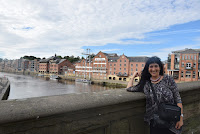We left the hotel fairly early and strolled in the opposite direction of the train station heading to the heart of the city, which straddles the river Ouse, in search of some of York's historical imprints.
Micklegate used to be part of the long road between London and Edimburgh. Its importance attracted the richer residents of the city and medieval mercants and leading Georgian businessmen built their townhouses (amongst which the one turned into the hotel we were staying at) there.

Along the way we came across St. John's Micklegate, a grade II listed church which became aYorks Art Centre and is said to have been used as a bar recently (... how interestingly odd!).



We soon reached a huge mound topped by Clifford's Tower which has a dramatic story - built by William the conqueror to keep the North country under control it was burned down by the Danes within a year of existence. Another wooden keep is said to have been built afterwards but burned down again in anti-Jewish riots in 1910. Some 150 Jews took their own lives when they were trapped in the tower by the mob. It is then thought that the tower was then set alight to try to erase all trace of the horror (the plaque to their memory is to be seen underneath on the left).
The stone tower completed in 1270 was heavily fortified and then wrecked in 1684 when a fire, which according to some was started deliberately, blew off the roof, leaving the structure as it is today.


(To be continued)









No comments:
Post a Comment